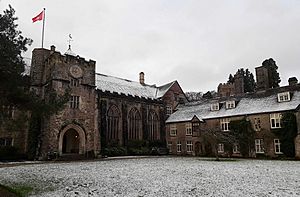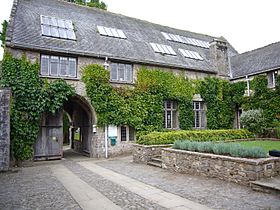Dartington Hall facts for kids
Dartington Hall is a very old house and large estate in Dartington, near Totnes, in Devon, England. It covers about 1,200 acres (4.9 km²). The main buildings were built in the late 1300s and are considered very important historic buildings. Experts say it's one of the most amazing old houses still standing from medieval England.
The old buildings are built around a huge courtyard. This courtyard was the biggest one built for a private home before the 1500s! The Great Hall inside is also one of the best of its time in England. These medieval buildings were carefully fixed up between 1926 and 1938.
Today, Dartington Hall is home to the Dartington Trust. This is a charity that runs many educational programs. These include Schumacher College, Dartington Arts School, and the Dartington Music Summer School & Festival. The Trust also hosts other groups and events at Dartington Hall.
Contents
History of Dartington Hall
The land of Dartington was owned by the Martin family from the early 1100s to the mid-1300s. After William Martin died in 1326, the land went back to the King. In 1384, King Richard II gave it to his half-brother, John Holland, 1st Duke of Exeter.
Building the Great Hall
The 1st Duke, John Holland, built the amazing medieval Great Hall between 1388 and 1400. You can still see the carved symbols of King Richard II above the porch.
After the 1st Duke was executed by King Henry IV, Dartington Hall stayed with his family. His son, John Holland, 2nd Duke of Exeter, and then his grandson, Henry Holland, 3rd Duke of Exeter, lived there. When the 3rd Duke died in 1475 without children, Dartington Hall went back to the King again.
In 1559, Sir Arthur Champernowne bought the hall. He was a Vice-Admiral under Queen Elizabeth I. His family lived in Dartington Hall for 366 years, until 1925!
By 1925, much of the hall was falling apart. That's when a rich couple, Leonard Elmhirst and his wife Dorothy Elmhirst, bought it. They hired an architect named William Weir to fix up the old buildings. They especially worked hard to restore the Great Hall's special wooden roof, called a hammerbeam roof.
The Dartington Experiment
The Elmhirsts wanted to try new ideas for improving life in the countryside. They were inspired by Rabindranath Tagore, a famous Indian poet and philosopher. He had visited Dartington and encouraged Leonard Elmhirst to buy the estate.
The Elmhirsts put a lot of energy and money into new projects. They started different departments on the estate to help the local area. These projects included:
- Supporting peace movements and new ideas.
- Creating new ways of teaching, which led to the Dartington School.
- Encouraging arts like pottery and textiles. By 1938, Dartington was a safe place for many artists and performers from Europe.
- Trying new farming methods, which became a place for research.
In 1928, Leonard Elmhirst worked with Alice Blinn to plan a training center for home skills. Blinn suggested modernizing homes in the village with new kitchens and laundries. Although Blinn didn't move to England, some of her ideas for kitchen equipment were used.
In 1935, the Dartington Hall Trust was set up. This is a registered charity that now runs the estate.
Many new buildings were constructed during this time. High Cross House, built in 1932, was designed by a Swiss-American architect and is an important example of modern architecture. Other buildings like Aller Park and Foxhole were built for the Dartington Hall School. An arts center, dance school, and student center were also added.
Dartington Today
Today, the estate still has many of the buildings from the Elmhirsts' time. The old Dartington Hall School closed in 1987. High Cross House is now used by the Dartington Trust's teachers. Other buildings host the Arts at Dartington, the Music Summer School, and research programs. The Cider Press Centre, a shopping area, is also run by the Trust.
In September 2022, university students returned to Dartington. They started a new degree program called BSc Regenerative Food and Farming. This is the first degree in England to focus on farming in a way that helps the environment.
The Great Hall and its medieval courtyard are now used for conferences and weddings. They also offer places to stay for visitors and people attending courses. The Barn Cinema and the White Hart Bar and Restaurant are popular with local people and visitors.
The Dartington Trust also helped set up other important places. The Beaford Centre in North Devon was created in the 1960s to bring arts and jobs to a rural area. The Trust also started the Dartington Crystal factory in 1967, which makes beautiful glass.
Dartington Music Summer School & Festival
The Dartington Music Summer School & Festival is a part of the Dartington Trust. It's a special event that brings together top musicians and composers with students and amateur musicians. They all work together in concerts and classes in a friendly atmosphere.
People who attend, whether they are beginners or advanced students, spend their days learning different types of music. In the evenings, they can go to concerts or even perform themselves. There are classes for instruments, singing, composing music, opera, and even non-classical music like Jazz and Salsa. Many famous composers have taught here.
Dartington Gardens
The gardens at Dartington were designed by Dorothy Elmhirst with help from famous landscape designers. They have a special area called a "tiltyard," which might have been an old water garden. You can also see many sculptures by famous artists like Henry Moore.
There's a very old yew tree in the gardens, which is thought to be nearly 2000 years old! There's a legend that Knights Templar are buried in the graveyard, but there's no proof of this.
Past Activities
Dartington Hall School
Dartington Hall School was founded in 1926. It was a special school that allowed boys and girls to learn together and live at the school. At first, there weren't many formal classes. Children learned by helping with activities on the estate. The school had very progressive rules:
- No physical punishment.
- No prefects (older students in charge).
- No uniforms.
- No forced games or religion.
- No competition.
Over time, more academic lessons were added. The school was known for its unique approach to education. Many notable people attended the school, including Lord Young, who helped start Which? magazine and the Open University. Artists like Lucian Freud and his brother Clement Freud also went there.
The school's headmaster from 1931 to 1957, W. B. Curry, wrote two books about it. The author Dennis Wheatley even wrote a fictional book based on some events at the school.
At its busiest, the school had about 300 students. However, as other schools started to offer similar progressive education, and after the founders passed away, the school faced challenges. It closed in 1987. After it closed, some staff and students started Sands School, which still follows some of Dartington's original ideas.
Dartington College of Arts
Dartington College of Arts was a special arts school located at the hall from 1961 to 2010. It was well-known around the world for its excellent teaching, especially in performance arts. In 2008, it became part of University College Falmouth and moved to Falmouth.
In 2021, the Dartington Trust reopened the Dartington Arts School. It now offers new Masters degree programs, focusing on topics like Arts and Place, Arts and Ecology, and Poetics of Imagination.
Images for kids












